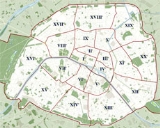
Rue de Provence
Encyclopedia

IXe arrondissement
The 9th arrondissement , located on the Right Bank, is one of the 20 arrondissements of Paris, France. It contains many places of cultural, historical, and architectural interest, including the Palais Garnier, home to the Paris Opera, Boulevard Haussmann and its large department stores of Galeries...
of Paris. Only the short part of the street between rue du Havre and rue de Rome is in the VIIIe arrondissement
VIIIe arrondissement
The 8th arrondissement of Paris is one of the 20 arrondissements of the capital city of France.Situated on the right bank of the River Seine and centred on the Opéra, the 8th is, together with the 1st and 9th arrondissements and 16th arrondissement and 17th arrondissement, one of Paris's main...
.
At this place was a little river called "ruisseau de Menilmontant" (Menilmontant brook). With the Parisian population increasing, this little river became the Grand Egout (main sewer) with a two-meter width in the 17th century.
Letters patent
Letters patent
Letters patent are a type of legal instrument in the form of a published written order issued by a monarch or president, generally granting an office, right, monopoly, title, or status to a person or corporation...
of 15 December 1770 allowed the banker Jean-Joseph de Laborde
Jean-Joseph de Laborde
- Biography:Laborde was born near Jaca in Aragon, into a modest béarnaise family. When he reached adolescence he joined his uncle, who was head of a maritime import-export company at Saint-Jean-de-Luz, and took over as head of the business on the cousin's death...
to create a 30-foot wide street by covering the "Grand Egout".
"Provence" is the name of a region in the south-east of France, but the name of the street is in honour of Louis-Stanislas-Xavier, comte de Provence, king of France from 1814 to 1824 under the name of Louis XVIII.

Notable places
- n° 22 (corner of rue Chauchat): 18th-century mansion transformed by Samuel BingSamuel BingSiegfried Bing , often referenced erroneously as "Samuel Bing", was a German art dealer who lived in Paris as an adult, and who helped introduce Japanese art and artworks to the West and was a factor in the development of the Art Nouveau style during the late nineteenth century.-Biography:Bing was...
into an Art Nouveau exposition building in 1895. Sold in 1904 to the ebenist Majorelle as an exposition room. Now a post office keeping the exterior decoration. - n° 32: Rare example of a building built in the late 1790s.
- n° 34: The door should be the only one remaining from the hôtel ThellussonHôtel ThellussonThe Hôtel Thellusson was a luxurious hôtel particulier, built in 1778 by Claude-Nicolas Ledoux for Marie-Jeanne Girardot de Vermenoux , widow of the banker from Geneva Georges-Tobie de Thellusson ....
built in 1778 by Claude-Nicolas Ledoux for the widow of the Swiss banker Georges-Tobie de Thellusson. The opening of the hotel on the rue de Provence was a huge triumphal arch. The hotel was destroyed in 1826 when the rue LaffitteRue LaffitteRue Laffitte is a street in Paris' IXe arrondissement.This street was created in 1771 between the Boulevard des Italiens and the Rue de Provence. Its original name was Rue d'Artois, in honour of the Comte d'Artois, brother of the king Louis XVI, later king of France with the name of Charles X...
was lengthened. - n° 122: location of one of the most famous former lupanars, the One-two-two.
- n° 126: Building built in 1911 by Henri SauvageHenri SauvageHenri Sauvage was a French architectural designer.Sauvage was born in Rouen, France. After studying at the École nationale supérieure des Beaux-Arts in the atelier of Jean-Louis Pascal, he opened a wallpaper shop in Paris for which he got orders from Hector Guimard and Louis Majorelle, he then...
and Charles Sarrazin for the French decorator Louis MajorelleLouis MajorelleLouis-Jean-Sylvestre Majorelle, usually known simply as Louis Majorelle, was a French decorator and furniture designer who manufactured his own designs, in the French tradition of the ébéniste...
.

